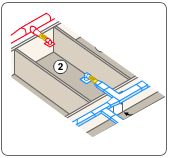|
 
Lab IntroductionSome labs are best operated at a constant volume. This lab has no ventilated equipment. The reason for the constant volume requirement is either thermal demand (there is a consistently high heat load, such as a room full of freezers), a high air change requirement (e.g., a vivarium), or a small volume room where the added first cost of VAV is not economically justified by operating savings (e.g., a cold room). If the air volume serving the space can be varied economically, this lab should be designed as a VAV lab (see zone 6). Sequence of OperationsIntroductionPhoenix Controls venturi air valves can be used to maintain a net negative or positive pressure relationship between critical use rooms and an adjacent corridor or room. Such pressurization controls are typically applied in clean rooms, special process areas, hospital operating rooms and in rooms without fume hoods within laboratory facilities. In this application, a constant volume valve (CVV) is used to maintain a constant supply volume into the zone as the static pressure in the supply duct system fluctuates. The zone's thermal load is assumed to be low enough that the supply air volume, having been sized to satisfy the ventilation rate (calculated from air changes per hour), also maintains space temperature. The general exhaust volume leaving the zone is also controlled with a constant volume valve. This valve maintains a constant exhaust volume out of the zone as the static pressure in the exhaust duct system fluctuates. The general exhaust (GEX) volume is sized so that, in conjunction with the zone's supply air volume, the desired net negative or positive room offset volume is provided. By having a pressure independent valve on both the supply and general exhaust sources, zone pressurization control is maintained. Independently, the zone thermostat controls the reheat coil to provide zone temperature control. Static Pressure FluctuationsAs the supply system static pressure fluctuates, the constant volume supply valve's pressure independent cone/spring assembly shall modulate to maintain a fixed volume of supply into the zone within one second. As the exhaust system static pressure fluctuates, the constant volume general exhaust valve's pressure independent cone/spring assembly shall also modulate to maintain a fixed exhaust volume out of the zone within one second. Room PressurizationIf a negative room offset volume is desired, the CVV supply valve shall be factory pre-set to a volume at least 10% less than that of the CVV general exhaust valve, also factory pre-set. This shall result in a room offset volume that enters the zone from the corridor or adjacent spaces, thereby providing pressurization control of the zone. [If a positive room offset volume is desired, the CVV supply valve shall be pre-set to a volume at least 10% greater than that of the CVV GEX valve. This shall result in a room offset volume that leaves the zone and enters the corridor or adjacent spaces, thereby providing pressurization control of the zone.] Temperature ControlIndependently, the zone thermostat shall control the reheat coil. Fail-safe ConditionSince constant volume valves require neither pneumatic air nor power, a fail-safe condition does not apply to the valves in this application. |
  |
||||||
| HOME | MARKETS | PRODUCTS | SERVICES | CASE STUDIES | INCENTIVES | ABOUT US | ||||||
|
||||||
| HOME | MARKETS | PRODUCTS | SERVICES | CASE STUDIES | INCENTIVES | ABOUT US | CONTACT US | SITE MAP ©2007 All rights reserved. Newmatic Engineering. Website by SR Designs. |
||||||
